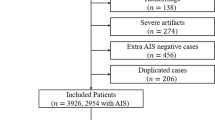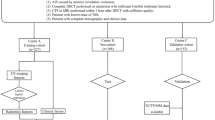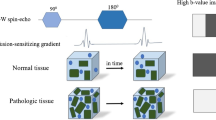Abstract
Objectives
To develop and validate a deep learning model for predicting hemorrhagic transformation after endovascular thrombectomy using dual-energy computed tomography (CT).
Materials and methods
This was a retrospective study from a prospective registry of acute ischemic stroke. Patients admitted between May 2019 and February 2023 who underwent endovascular thrombectomy for acute anterior circulation occlusions were enrolled. Hemorrhagic transformation was defined using follow-up magnetic resonance imaging or CT. The deep learning model was developed using post-thrombectomy dual-energy CT to predict hemorrhagic transformation within 72 h. Temporal validation was performed with patients who were admitted after July 2022. The deep learning model’s performance was compared with a logistic regression model developed from clinical variables using the area under the receiver operating characteristic curve (AUC).
Results
Total of 202 patients (mean age 71.4 years ± 14.5 [standard deviation], 92 men) were included, with 109 (54.0%) patients having hemorrhagic transformation. The deep learning model performed consistently well, showing an average AUC of 0.867 (95% confidence interval [CI], 0.815–0.902) upon five-fold cross validation and AUC of 0.911 (95% CI, 0.774–1.000) with the test dataset. The clinical variable model showed an AUC of 0.775 (95% CI, 0.709–0.842) on the training dataset (p < 0.01) and AUC of 0.634 (95% CI, 0.385–0.883) on the test dataset (p = 0.06).
Conclusion
A deep learning model was developed and validated for prediction of hemorrhagic transformation after endovascular thrombectomy in patients with acute stroke using dual-energy computed tomography.
Clinical relevance statement
This study demonstrates that a convolutional neural network (CNN) can be utilized on dual-energy computed tomography (DECT) for the accurate prediction of hemorrhagic transformation after thrombectomy. The CNN achieves high performance without the need for region of interest drawing.
Key Points
• Iodine leakage on dual-energy CT after thrombectomy may be from blood-brain barrier disruption.
• A convolutional neural network on post-thrombectomy dual-energy CT enables individualized prediction of hemorrhagic transformation.
• Iodine leakage is an important predictor of hemorrhagic transformation following thrombectomy for ischemic stroke.



Similar content being viewed by others
Abbreviations
- AUC:
-
Area under the receiver operating characteristic curve
- CNN:
-
Convolutional neural network
- DECT:
-
Dual-energy computed tomography
- DICOM:
-
Digital Imaging and Communications in Medicine
- EVT:
-
Endovascular thrombectomy
- MRI:
-
Magnetic resonance imaging
References
Hao Y, Zhang Z, Zhang H et al (2017) Risk of intracranial hemorrhage after endovascular treatment for acute ischemic stroke: systematic review and meta-analysis. Interv Neurol 6:57–64
Zhang J, Yang Y, Sun H, Xing Y (2014) Hemorrhagic transformation after cerebral infarction: current concepts and challenges. Ann Transl Med 2:81
Jadhav AP, Molyneaux BJ, Hill MD, Jovin TG (2018) Care of the post-thrombectomy patient. Stroke 49:2801–2807
Lu G, He Q, Shen Y, Cao F (2018) Potential biomarkers for predicting hemorrhagic transformation of ischemic stroke. Int J Neurosci 128:79–89
Iwamoto T, Kitano T, Oyama N, Yagita Y (2021) Predicting hemorrhagic transformation after large vessel occlusion stroke in the era of mechanical thrombectomy. PLoS One 16:e0256170
Marsh EB, Llinas RH, Schneider ALC et al (2016) Predicting hemorrhagic transformation of acute ischemic stroke. Medicine (Baltimore) 95:e2430
Aviv RI, d’Esterre CD, Murphy BD et al (2009) Hemorrhagic transformation of ischemic stroke: prediction with CT perfusion. Radiology 250:867–877
Yu Y, Guo D, Lou M et al (2018) Prediction of hemorrhagic transformation severity in acute stroke from source perfusion MRI. IEEE Trans Biomed Eng 65:2058–2065
Tian B, Tian X, Shi Z et al (2022) Clinical and imaging indicators of hemorrhagic transformation in acute ischemic stroke after endovascular thrombectomy. Stroke 53:1674–1681
Yu S, Zhang H, Jiang Q-M et al (2023) Value of angiographic regional circulation signs in predicting hemorrhagic transformation after endovascular thrombectomy. J Neuroradiol 50:327–332
Gupta R, Phan CM, Leidecker C et al (2010) Evaluation of dual-energy CT for differentiating intracerebral hemorrhage from iodinated contrast material staining. Radiology 257:205–211
Renú A, Amaro S, Laredo C et al (2015) Relevance of blood–brain barrier disruption after endovascular treatment of ischemic stroke. Stroke 46:673–679
Khatri R, McKinney AM, Swenson B, Janardhan V (2012) Blood–brain barrier, reperfusion injury, and hemorrhagic transformation in acute ischemic stroke. Neurology 79:S52–S57
Baik M, Cha J, Ahn SS et al (2022) Dual-energy computed tomography quantification of extravasated iodine and hemorrhagic transformation after thrombectomy. J Stroke Cerebrovasc Dis 24:152–155
Bonatti M, Lombardo F, Zamboni GA et al (2018) Iodine extravasation quantification on dual-energy CT of the brain performed after mechanical thrombectomy for acute ischemic stroke can predict hemorrhagic complications. AJNR Am J Neuroradiol 39:441–447
Bonkhoff AK, Grefkes C (2021) Precision medicine in stroke: towards personalized outcome predictions using artificial intelligence. Brain 145:457–475
Heo J, Yoon JG, Park H et al (2019) Machine learning-based model for prediction of outcomes in acute stroke. Stroke 50:1263–1265
Kamal H, Lopez V, Sheth SA (2018) Machine learning in acute ischemic stroke neuroimaging. Front Neurol 9:945
Tan JC, Dillon WP, Liu S et al (2007) Systematic comparison of perfusion-CT and CT-angiography in acute stroke patients. Ann Neurol 61:533–543
Larrue V, von Kummer RR, Müller A, Bluhmki E (2001) Risk factors for severe hemorrhagic transformation in ischemic stroke patients treated with recombinant tissue plasminogen activator: a secondary analysis of the European-Australasian Acute Stroke Study (ECASS II). Stroke 32:438–441
Fan H, Murrell T, Wang H et al (2021) PyTorchVideo: a deep learning library for video understanding. ArXiv, abs/2111.09234
Feichtenhofer C, Fan H, Malik J, He K (2019) SlowFast networks for video recognition. In: 2019 IEEE/CVF International Conference On Computer Vision (ICCV). IEEE
Paszke A, Gross S, Massa F et al (2019) PyTorch: an imperative style, high-performance deep learning library. In: Advances in neural information processing systems 32 (NeurIPS 2019)
Nogueira RG, Gupta R, Jovin TG et al (2015) Predictors and clinical relevance of hemorrhagic transformation after endovascular therapy for anterior circulation large vessel occlusion strokes: a multicenter retrospective analysis of 1122 patients. J Neurointerv Surg 7:16–21
Sugiura Y, Yamagami H, Sakai N, Yoshimura S (2017) Predictors of symptomatic intracranial hemorrhage after endovascular therapy in acute ischemic stroke with large vessel occlusion. J Stroke Cerebrovasc Dis 26:766–771
Bang OY, Saver JL, Kim SJ et al (2011) Collateral flow averts hemorrhagic transformation after endovascular therapy for acute ischemic stroke. Stroke 42:2235–2239
Natarajan SK, Karmon Y, Snyder KV et al (2010) Prospective acute ischemic stroke outcomes after endovascular therapy: a real-world experience. World Neurosurg 74:455–464
R Core Team (2013) R: a language and environment for statistical computing. R Foundation for Statistical Computing, Vienna
Mongan J, Moy L, Kahn CE Jr (2020) Checklist for artificial intelligence in medical imaging (CLAIM): a guide for authors and reviewers. Radiol Artif Intell 2:e200029
Zhou B, Khosla A, Lapedriza A et al (2016) Learning deep features for discriminative localization. In: 2016 IEEE Conference on Computer Vision and Pattern Recognition (CVPR), pp 2921–2929
Nishimoto T, Oka F, Okazaki K, Ishihara H (2022) Timing of direct oral anticoagulants for hemorrhagic transformation after endovascular treatment in acute ischemic stroke. J Stroke Cerebrovasc Dis 31:106507
Murray NM, Unberath M, Hager GD, Hui FK (2020) Artificial intelligence to diagnose ischemic stroke and identify large vessel occlusions: a systematic review. J Neurointerv Surg 12:156–164
Adhya J, Li C, Eisenmenger L et al (2021) Positive predictive value and stroke workflow outcomes using automated vessel density (RAPID-CTA) in stroke patients: one year experience. Neuroradiol J 34:476–481
Suh CH, Jung SC, Cho SJ et al (2019) Perfusion CT for prediction of hemorrhagic transformation in acute ischemic stroke: a systematic review and meta-analysis. Eur Radiol 29:4077–4087
Krishnamoorthy S, Singh G, Jose KJ et al (2022) Biomarkers in the prediction of hemorrhagic transformation in acute stroke: a systematic review and meta-analysis. Cerebrovasc Dis 51:235–247
Ma C, Xu D, Hui Q et al (2022) Quantitative intracerebral iodine extravasation in risk stratification for intracranial hemorrhage in patients with acute ischemic stroke. AJNR Am J Neuroradiol 43:1589–1596
Arba F, Rinaldi C, Caimano D et al (2020) Blood-brain barrier disruption and hemorrhagic transformation in acute ischemic stroke: systematic review and meta-analysis. Front Neurol 11:594613
Funding
The authors state that this work has not received any funding.
Author information
Authors and Affiliations
Corresponding author
Ethics declarations
Guarantor
The scientific guarantor of this publication is Beomseok Sohn.
Conflict of interest
The authors of this manuscript declare relationships with the following companies:
Author Youngno Yoon declares the following conflict of interest statement. Although Youngno Yoon is the CEO of Bright Data, during the preparation of this research paper, Youngno Yoon solely participated as a researcher and did not utilize any resources or involvement from Bright Data. Youngno Yoon’s affiliation with Bright Data does not influence the objectivity, integrity, or impartiality of the research findings presented in this paper.
The other authors of this manuscript declare no relationships with any companies, whose products or services may be related to the subject matter of the article.
Statistics and biometry
Author JoonNyung Heo has significant statistical expertise.
Kyunghwa Han kindly provided her statistical advice for this manuscript.
Informed consent
Written informed consent was waived by the Institutional Review Board, owing to the retrospective nature of the study.
Ethical approval
Institutional Review Board approval was obtained. This study was approved by the Institutional Review Board of Yonsei University College of Medicine (approval number: 4-2022-0928), with a waiver of informed consent owing to the retrospective nature of the study.
Study subjects or cohorts overlap
No study subjects or cohorts have been previously reported.
Methodology
• retrospective
• observational
• performed at one institution
Additional information
Publisher's Note
Springer Nature remains neutral with regard to jurisdictional claims in published maps and institutional affiliations.
J. Heo and Y. Yoon are co-first authors.
Supplementary Information
Below is the link to the electronic supplementary material.
Rights and permissions
Springer Nature or its licensor (e.g. a society or other partner) holds exclusive rights to this article under a publishing agreement with the author(s) or other rightsholder(s); author self-archiving of the accepted manuscript version of this article is solely governed by the terms of such publishing agreement and applicable law.
About this article
Cite this article
Heo, J., Yoon, Y., Han, H.J. et al. Prediction of cerebral hemorrhagic transformation after thrombectomy using a deep learning of dual-energy CT. Eur Radiol 34, 3840–3848 (2024). https://doi.org/10.1007/s00330-023-10432-6
Received:
Revised:
Accepted:
Published:
Issue Date:
DOI: https://doi.org/10.1007/s00330-023-10432-6




